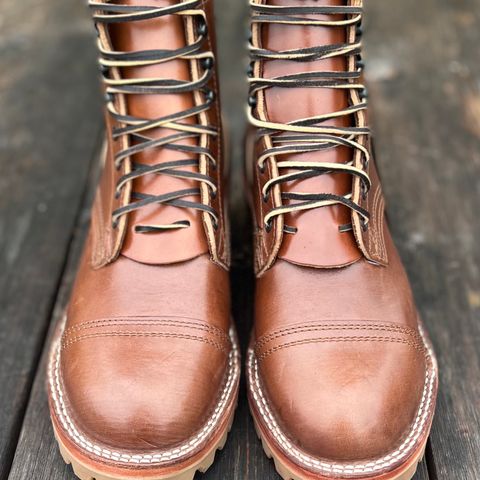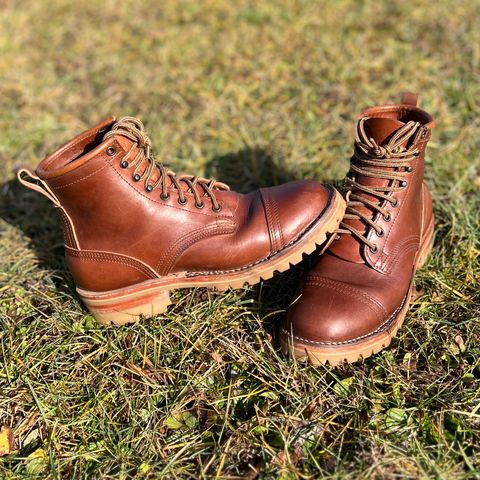About
Wickett & Craig Brown Oiled Latigo is a color variation of oiled latigo leather produced by Wickett & Craig, an American vegetable tannery. The leather is hot-dipped in a proprietary mix of oils, waxes, and tallows, resulting in a strong, pliable material with weather-resistant properties. Available in shades including tan, chestnut, and medium brown, this leather is commonly used in heritage footwear, strap goods, and leather accessories.
About
Wickett & Craig Brown Oiled Latigo is a color variation of oiled latigo leather produced by Wickett & Craig, an American vegetable tannery. The leather is hot-dipped in a proprietary mix of oils, waxes, and tallows, resulting in a strong, pliable material with weather-resistant properties. Available in shades including tan, chestnut, and medium brown, this leather is commonly used in heritage footwear, strap goods, and leather accessories.
Founded in 1867 and now located in Curwensville, Pennsylvania, Wickett & Craig is one of only two remaining vegetable tanneries in the United States. The company produces approximately 4,500,000 square feet of leather annually using a labor-intensive, natural tanning process that takes six weeks. Brown oiled latigo represents one of the tannery's signature products, combining traditional vegetable tanning methods with hot-stuffing techniques that saturate the leather with oils and waxes.
Product specifications
Wickett & Craig brown oiled latigo is sold by side and back, with sides averaging 24-27 square feet and backs averaging 18-20 square feet. The leather is available in weights ranging from 2-3 oz. to 12-14 oz., with 4-5 oz. (1.6-2 mm) being a common weight for footwear applications. Full-grain hides are graded as A/B quality with a medium to firm temper.
Brown color variations include tan, chestnut, burgundy, and medium brown. The leather is priced by square foot with three quality grades: Standard grade ranges from $241-$274, Utility grade from $225-$258, and Special grade from $211-$241. Individual hides average 25 square feet and are priced between $303-$319 for 4-5 oz. weight.
Manufacturing process
The production of brown oiled latigo begins with Wickett & Craig's vegetable tanning process, which uses tannins derived from Mimosa and Quebracho tree bark. Raw hides from North American cattle of European stock undergo a six-week tanning process that includes pre-tanning, splitting, drying, dyeing, and fat-liquoring with oils and waxes.
The distinguishing characteristic of oiled latigo is the hot-stuffing process, where the vegetable-tanned leather is hot-dipped in a special proprietary blend of oils, waxes, and tallows. This treatment fully conditions the leather and imparts its characteristic depth of color. The brown coloration is achieved through drum dyeing with varying shades, with the final color influenced by both the dyes applied and the oils and waxes used in the hot-stuffing process. The leather undergoes finishing and grading before shipment, with each hide receiving environmental certification from the Leather Working Group.
Characteristics
Brown oiled latigo exhibits several defining physical characteristics. The leather is strong and pliable with a fully conditioned texture and high oil content that can cause leaching. The material is weather-resistant and water-repellent, able to repel water while maintaining its structure. Lighter brown tones display a pull-up characteristic, a signature trait of high-quality full-grain leathers where stressed areas temporarily lighten in color.
The leather develops a patina with use, slowly darkening over its lifetime. Boots and goods made from brown oiled latigo gain character and uniqueness as they age, with the vegetable-tanned material developing a rich patina. The leather's high oil concentration highlights the grain and character while providing natural water resistance. However, the material may show marks, scuffs, or stains more readily than other leathers, though regular conditioning greatly mitigates these visible effects.
Applications
Brown oiled latigo serves multiple applications in leather goods manufacturing. The material is particularly suitable for strap goods, where its strength and pliability provide durability under tension. When split to lighter weights, the leather works well for shoes, bags, briefcases, and wallets.
Heritage boot manufacturers including Nick's Boots, Baker's Boots, and White's Boots use Wickett & Craig brown oiled latigo for premium work and heritage boot construction. The leather's combination of strength, water resistance, and aging characteristics makes it appropriate for footwear subjected to demanding conditions. Small leather goods manufacturers also specify the material for products including belts, wallets, and accessories where the leather's pull-up effect and patina development are desirable features.
Care and maintenance
Brown oiled latigo requires specific care to maintain its condition and appearance. The leather should be cleaned with warm water and mild saddle soap, avoiding harsh chemicals that can strip the natural oils. Conditioning every six to 12 months helps maintain the leather's suppleness and mitigates visible wear, marks, and scuffs.
Although the leather has water-repellent properties due to its high oil content, it is not inherently water-resistant as a vegetable-tanned material. Proper care requires protection from excessive moisture. Storage should be indoors, away from humidity that can affect the leather's condition. For additional water resistance, beeswax can be applied to the leather's surface, though this will alter the appearance and patina development characteristics.
References
"Oiled Latigo". Wickett-Craig. Retrieved October 10, 2025.
"Wickett & Craig - Show Harness/Oiled Latigo - 4/5oz". Maverick Leather Company. Retrieved October 10, 2025.
Wickett-Craig. "Wickett-Craig - Superior Leather Since 1867". Retrieved October 10, 2025.
Nick's Boots. "Wickett & Craig Work Heritage Boots". Retrieved October 10, 2025.
"Our Leathers". Wickett-Craig. Retrieved October 10, 2025.

































































